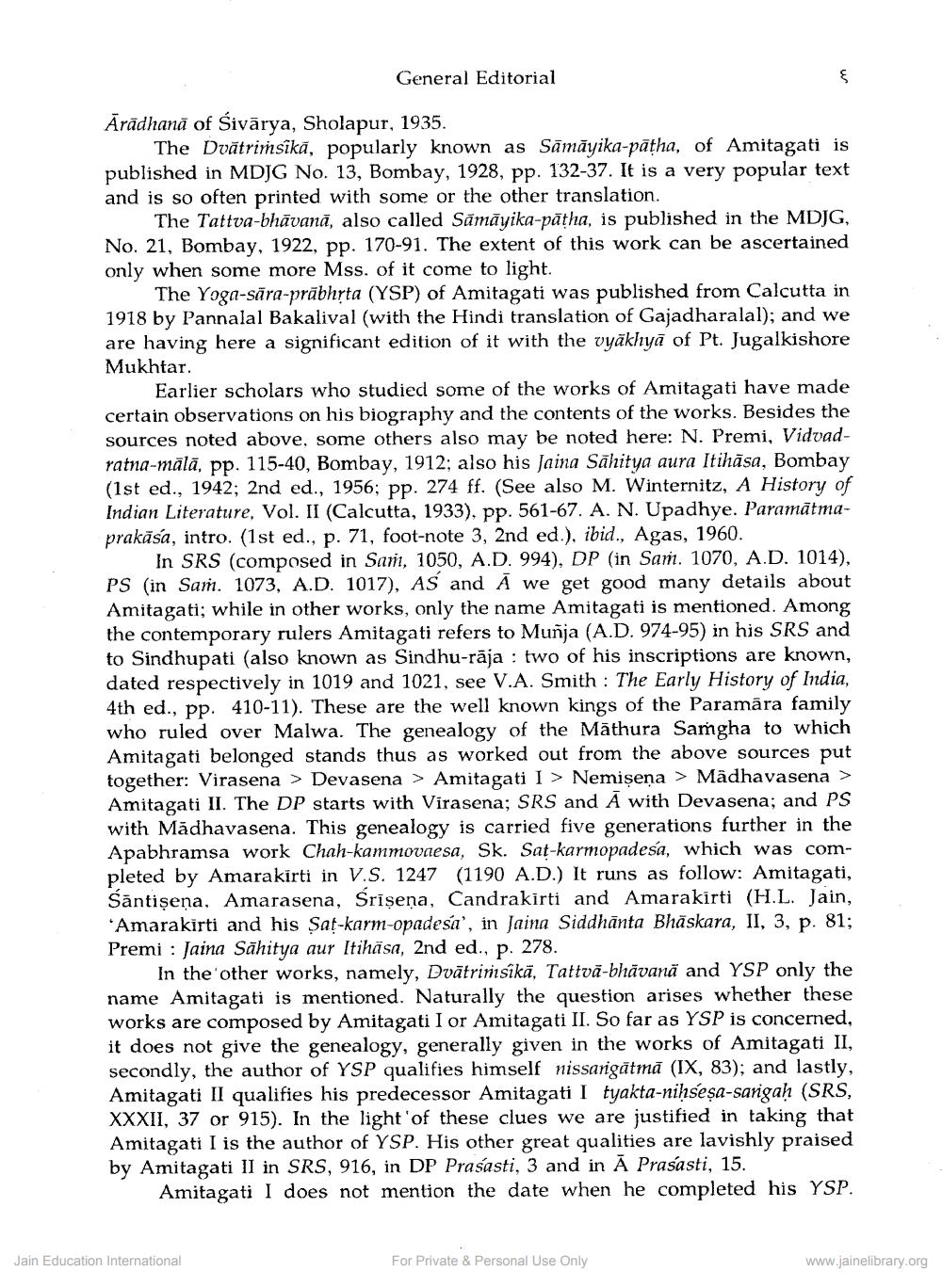________________
General Editorial
Ārādhană of Sivārya, Sholapur, 1935.
The Dvātrimsîkā, popularly known as Sāmāyika-pātha, of Amitagati is published in MDJG No. 13, Bombay, 1928, pp. 132-37. It is a very popular text and is so often printed with some or the other translation.
The Tattva-bhāvanā, also called Sāmāyika-pātha, is published in the MDJG, No. 21, Bombay, 1922, pp. 170-91. The extent of this work can be ascertained only when some more Mss. of it come to light
The Yoga-sāra-prābhrta (YSP) of Amitagati was published from Calcutta in 1918 by Pannalal Bakalival (with the Hindi translation of Gajadharalal); and we are having here a significant edition of it with the vyākhyā of Pt. Jugalkishore Mukhtar.
Earlier scholars who studied some of the works of Amitagati have made certain observations on his biography and the contents of the works. Besides the sources noted above, some others also may be noted here: N. Premi, Vidvadratna-mālā, pp. 115-40, Bombay, 1912; also his Jaina Sāhitya aura Itihāsa, Bombay (1st ed., 1942; 2nd ed., 1956; pp. 274 ff. (See also M. Winternitz, A History of Indian Literature, Vol. II (Calcutta, 1933), pp. 561-67. A. N. Upadhye. Paramātmaprakāsa, intro. (1st ed., p. 71, foot-note 3, 2nd ed.), ibid., Agas, 1960.
In SRS (composed in Sam, 1050, A.D. 994), DP (in Sam. 1070, A.D. 1014), PS (in Sam. 1073, A.D. 1017), AS and A we get good many details about Amitagati; while in other works, only the name Amitagati is mentioned. Among the contemporary rulers Amitagati refers to Muñja (A.D. 974-95) in his SRS and to Sindhupati (also known as Sindhu-rāja : two of his inscriptions are known, dated respectively in 1019 and 1021, see V.A. Smith: The Early History of India, 4th ed., pp. 410-11). These are the well known kings of the Paramāra family who ruled over Malwa. The genealogy of the Māthura Samgha to which Amitagati belonged stands thus as worked out from the above sources put together: Virasena > Devasena > Amitagati I > Nemisena > Madhavasena > Amitagati II. The DP starts with Virasena; SRS and A with Devasena; and PS with Madhavasena. This genealogy is carried five generations further in the Apabhramsa work Chah-kammovaesa, Sk. Sat-karmopadesa, which was completed by Amarakirti in V.S. 1247 (1190 A.D.) It runs as follow: Amitagati, śāntişena. Amarasena, Srīşena, Candrakirti and Amarakirti (H.L. Jain, *Amarakirti and his Sat-karm-opadesa', in Jaina Siddhānta Bhaskara, II, 3, p. 81; Premi : Jaina Sahitya aur Itihasa, 2nd ed., p. 278.
In the other works, namely, Dvātrimsikā, Tattva-bhāvanā and YSP only the name Amitagati is mentioned. Naturally the question arises whether these works are composed by Amitagati I or Amitagati II. So far as YSP is concerned, it does not give the genealogy, generally given in the works of Amitagati II, secondly, the author of YSP qualifies himself nissargātmā (IX, 83); and lastly, Amitagati Il qualifies his predecessor Amitagati I tyakta-nihsesa-sargah (SRS, XXXII, 37 or 915). In the light of these clues we are justified in taking that Amitagati I is the author of YSP. His other great qualities are lavishly praised by Amitagati II in SRS, 916, in DP Prasasti, 3 and in A Prasasti, 15.
Amitagati I does not mention the date when he completed his YSP.
Jain Education International
For Private & Personal Use Only
www.jainelibrary.org




